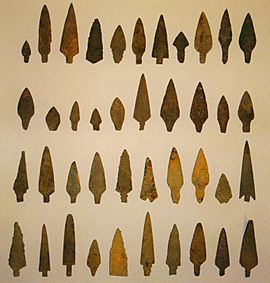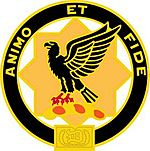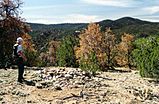Battle of Cieneguilla facts for kids
Quick facts for kids Battle of Cieneguilla |
|||||||
|---|---|---|---|---|---|---|---|
| Part of the Jicarilla War, Apache Wars, Ute Wars | |||||||
 Metal points from the Cieneguilla Battle Site. |
|||||||
|
|||||||
| Belligerents | |||||||
| Apache Ute |
|||||||
| Commanders and leaders | |||||||
| Flechas Rayada | John W. Davidson | ||||||
| Strength | |||||||
| 200 to 300 warriors | 60 cavalry | ||||||
| Casualties and losses | |||||||
| ~50 killed | 22 killed 36 wounded |
||||||
The Battle of Cieneguilla (say "sienna-GEE-ya") was an important fight during the Jicarilla War. It happened on March 30, 1854, near what is now Pilar, New Mexico. The battle involved Jicarilla Apache warriors, possibly with their Ute allies, fighting against soldiers from the American 1st Cavalry Regiment.
Newspaper reports at the time called it "one of the severest battles" between American troops and Native American groups. This battle was one of the first big clashes between American and Apache forces. It was also part of the Ute Wars, where Ute warriors tried to stop the United States from expanding into their lands in the Four Corners area.
Contents
Why Did the Battle Happen?
In March 1854, two companies of American soldiers, called Dragoons, were camped at Cantonment Burgwin. This was an army post about 10 miles southeast of Taos.
First Lieutenant John Wynn Davidson was leading 60 of these Dragoons on patrol. He went against the orders of his commander, Major Blake. Davidson decided to attack a Jicarilla Apache camp near Pilar, which was then known as Cieneguilla. This unauthorized attack led to the battle.
What Happened During the Battle?

On March 30, a group of about 250 Apaches and Utes set up a surprise attack for the U.S. soldiers. Lieutenant Davidson later reported that he "came upon the Apaches near Cieneguilla who at once sounded the war whoop."
According to Private James A. Bennett, who survived the fight, the battle lasted about four hours. It began around 8 a.m. and ended at 12 p.m. when the soldiers had to retreat to Ranchos de Taos. The Apache warriors used flintlock rifles and arrows.
Out of the 60 American soldiers, 22 were killed and 36 were wounded. They also lost 22 horses and much of their supplies. Some historians believe the fight was shorter, lasting closer to two hours. They also suggest the Apaches didn't ambush the soldiers but instead tricked them into attacking a much larger force.
What Happened After the Battle?
After the battle, Lieutenant Colonel Philip St. George Cooke quickly put together a group of soldiers to chase the Jicarilla. He had help from Pueblo Indian and Mexican scouts. Kit Carson, a famous guide, was also with them.
They chased the Jicarilla through the mountains during winter. On April 8, 1855, Cooke found and defeated them at their camp in the canyon of Ojo Caliente. The Jicarilla split into smaller groups to escape, but many died from the harsh cold weather.
Many people blamed Lieutenant Davidson for the heavy losses. They said he risked his soldiers' lives when he could have avoided the fight. However, Brig. Gen. John Garland praised Davidson. He said the troops showed great bravery. He also said Davidson showed excellent leadership to fight for three hours against so many enemies. Garland thought it was amazing that Davidson was able to retreat with the remaining soldiers.
On March 10, 1856, General Garland held an official meeting to investigate the battle. After hearing from many witnesses, the court decided that Davidson could not have avoided the fight. They also said he showed skill, carefulness, and courage during the long battle. They praised his efforts to bring the wounded soldiers to safety when he had to leave the battlefield.
How Do We Learn About the Battle Today?

In 2001, the Carson National Forest received money to study the Battle of Cieneguilla site. This money came from the National Park Service's American Battlefield Protection Program. It took a year to find the exact location of the battlefield.
Archaeologists found some old items at the site. The full results of their findings are in a book called Fields of Conflict, vol. 2 by Douglas Scott. These findings support some of the criticisms made against Lieutenant Davidson's battle plans. They also suggest that his command was indeed badly defeated.

